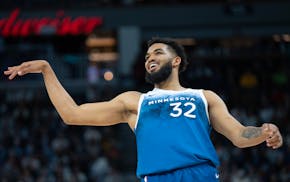There are four Division I men's basketball programs in Iowa: Northern Iowa, Drake, Iowa State and Iowa. The series of games between the teams has evolved into a one-day event at the Wells Fargo Arena in Des Moines.
It is called the "Big Four Classic," with Iowa State and Iowa trading off opponents — Drake one year, Northern Iowa the next — for a doubleheader that packs the arena.
The games were played Saturday, and Northern Iowa knocked off No. 5-rated Iowa State 81-79. Earlier this season, the Panthers received a visit from North Carolina and upset the Tar Heels 71-67.
"That was an exciting night for UNI," said Jim Sullivan, a sportswriter for the Waterloo-Cedar Falls Courier. "The McLeod Center was as packed as it can get, and when UNI won, there was the court storming, of course."
The excitement returned for UNI fans Saturday, with the victory over Iowa State. And one night later in a prime-time NFL game, David Johnson had 29 carries for 197 yards and three touchdowns in the Arizona's 40-17 thumping of Philadelphia.
What's the connection? Johnson is a rookie running back from Northern Iowa, and was taken in the third round by the Cardinals last spring.
We're here in Minnesota with a population of 5.4 million people and one university that has a full Division I athletic program. It long has puzzled me how our southern neighbors in Iowa, with a population of 3.1 million people, can support three of those (plus Drake).
Iowa and Iowa State are in the big five of conferences and have the TV money from football and basketball to sustain huge athletic budgets.
Northern Iowa is in the Missouri Valley Conference. The league doesn't sponsor football, so the Panthers also play in the Missouri Valley Football Conference — with five schools from the Mo Valley, four from the Summit League and Youngstown State.
It is an FCS conference, which means the schools can award 63 football scholarships rather than 85. Drake is also an FCS school, but it plays in the nonscholarship Pioneer League — which certainly reduces its chance to produce football players such as David Johnson.
Northern Iowa's campus is in Cedar Falls, which is a 10-minute drive from Waterloo. They are both in Blackhawk County. The metro area is claimed to total 165,000.
The Iowa State campus is 96 miles away in Ames. The University of Iowa campus is 89 miles away in Iowa City.
How does Northern Iowa raise the funds to operate a program that competes strongly in second-level football, continually springs upsets in basketball and has first-class programs in wrestling and volleyball, to name a couple?
"The fundraising is hard, but it's also different in Iowa, because we don't have professional sports," Troy Dannen said. "We have Vikings fans and Twins fans, Bears fans and Cubs fans, but those teams aren't in Iowa competing with us for ticket sales and donations.
"Down here, the equivalent of 'professional' athletics are the college teams, and there is a real sense of ownership with the public."
Dannen had been the athletic director at Northern Iowa for eight years. Early this month, it was announced that he would take over as the athletic director at Tulane, in New Orleans.
"That's not a reflection on Northern Iowa," Dannen said. "I'm a graduate of this school. My wife is from Iowa, too. We decided to try something different — living in a city. I also wanted to take a shot at a school with FBS football."
Northern Iowa opened its then-unique UNI-Dome in 1976. It left the Division II North Central Conference two years later. Eldon Miller came in as basketball coach in 1986 after being fired at Ohio State. Getting a coach with a name created the sense in Iowa that the Panthers truly were a Division I athletic program.
"Iowa is the monster, with an athletic budget pushing $100 million," Dannen said. "Iowa State is around $70 million. The Big Ten and Big 12 television revenues make them self-sustaining.
"We get basically no TV money. Our athletic budget is $14 million in real dollars, with $4 million of that in scholarships. We're generating roughly half of that — $5 million — and the state has been giving us the other $5 million."
If you're wondering why St. Cloud State, Minnesota State Mankato or Minnesota Duluth doesn't give FCS football and Division I (beyond hockey) a shot, I think Dannen answered it.
I can't see this state coming up with $5-6 million in public funds to supplement the yearly operation of a D-I athletic budget — not when Minnesotans have been so trained to worship at the Gophers' altar and merely tolerate athletics at our other state colleges.
Patrick Reusse can be heard 3-6 p.m. weekdays on AM-1500. • preusse@startribune.com

Reusse: Taylor's story. 'I just bought the Minnesota Timberwolves.'

Reusse: Back from injury, Towns doesn't have to carry load


